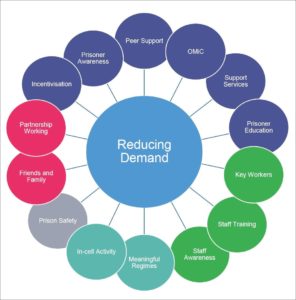Last week (3 April 2019) Her Majesty’s Prison and Probation Service (HMPPS) published its new Prison Drugs Strategy. There have, of course, always been drugs and drug misusers in prison but over the last six or seven years, with the advent of New Psychoactive Substances (NPS), the problem has become much worse.
The use of NPS has been seen as one of the two critical components of the prison safety crisis (the other being the unprecedented cuts in staffing levels). As the new strategy puts it:
The misuse of drugs contributes to a cycle of destruction and violence, leading to a reduced or unstable regime, which through unpredictability and lack of purpose can encourage prisons to turn to drugs and alcohol. The debts resulting from the supply, distribution and use of drugs is also a significant cause of violence, intimidation and self-harm across the estate, endangering both staff and other prisoners.
The prison drug strategy has been developed to support and complement the main government Drug Strategy published in 2017 and is centred around the same three objectives of restricting supply, reducing demand building recovery.
The prison drug strategy adopt a “5P” approach with each of the three objectives focusing on five key areas:
- People – that prisons have the right staff, with appropriate skills and support
- Procedural – that prison processes are clear, fair and effective
- Physical – that prison conditions are safe, clean, decent and promote well-being and recovery
- Population – that prisoners have positive relationships and engage in constructive activities
- Partnership – that all the organisations contributing to achieving our aims work together effectively
In order to do the strategy justice, I intend to look at each of the three objectives in turn in a series of blog posts starting with the objective of restricting supply.
Restricting supply
The strategy sets out three primary aims within the objective of restricting supply:
- Minimising the supply of drugs
- Finding contraband, and
- Disrupting illicit trade.
Readers will have seen many of the initiatives to prevent drugs getting into prisons. Recent funding has looked to upgrade and modernise security measures. In addition to the usual searches and dogs, the prison service is rolling out the use of x-ray scanners to detect internally concealed drugs and mobile phones and investing in new technology to prevent prisoners using mobile phones inside to organise drug supply. The service’s drug dogs have also been trained to detect New Psychoactive Substances and the strategy also directly mentions initiatives to combat staff corruption.
The strategy (implicitly) acknowledges that finding drugs in prison is a labour-intensive job and that reductions in staffing have had an impact. The strategy suggests that the main means of targeting searches for drugs will be prioritising prisoners who have failed Mandatory Drug Testing (MDT). One of my major criticisms of the strategy is that it continues to rely heavily on MDT despite the fact that numerous academic reviews have suggested that it is an unreliable basis on which to decide how best to tackle drug misuse in prison.
In terms of disrupting illicit trade, the strategy priorities the work of the HMPPS National Intelligence unit and its work with prisons, probation and police to proactively develop intelligence on offenders involved in the supply of drugs. The strategy also announces an investment of £1 million in a national digital categorisation service which will provide a wider range of informational male offenders come into prison, including those who may have the means to smuggle drugs, in order to support decisions about where their place and how the security risks they pose are managed. The new specialist financial crime unit has the powers to identify and freeze bank accounts linked to organised crime in prison.
The main activities set out in the strategy to restrict supply are summarised in the graphic below.
Thanks to Andy Aitchison for kind permission to use the header image. You can see Andy’s work here.






